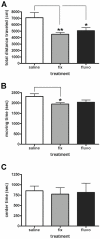Neonatal exposure to fluoxetine and fluvoxamine alteres spine density in mouse hippocampal CA1 pyramidal neurons
- PMID: 21326811
- PMCID: PMC3037202
Neonatal exposure to fluoxetine and fluvoxamine alteres spine density in mouse hippocampal CA1 pyramidal neurons
Abstract
Some women in childbearing ages take selective serotonin reuptake inhibitors (SSRIs) such as fluoxetine and fluvoxamine for treating psychiatric symptoms. However, these compounds may cause some side effects to their children. It has been identified that early life exposure to SSRIs increased the chance of developing mood disorders and the biological basis is still unclear. Here, we studied the effects of neonatal exposure to SSRIs on neuronal morphology. We used GFP-transgenic mice to investigate the acute and long-lasting effects of early life exposure to SSRIs on dendritic spine density of CA1 neurons. We found that 18-day drug applications of fluoxetine and fluvoxamine significantly reduced spine density of basal dendrites at postnatal day 22 (P22), but only fluvoxamine caused a reduction of spine density of apical dendrites. Interestingly, compared with the control group, the spine densities of basal dendrites after fluoxetine and fluvoxamine exposure and the spine density of apical dendrites after fluoxetine exposure increased in adult mice at the age of P90. We also observed impaired locomotor activity in adult mice after exposure to SSRIs. Our findings demonstrated that neonatal exposure to SSRIs was capable of influencing the morphological plasticity of excitatory synapses. It raised the caution for clinical use of SSRIs.
Keywords: SSRI; dendritic spine density; fluoxetine; fluvoxamine; neuronal development.
Figures



References
-
- Kessler RC, McGonagle KA, Swartz M, Blazer DG, Nelson CB. Sex and depression in the National Comorbidity Survey. I: Lifetime prevalence, chronicity and recurrence. J Affect Disord. 1993;29:85–96. - PubMed
-
- Potter WZ, Rudorfer MV, Manji H. The pharmacologic treatment of depression. N Engl J Med. 1991;325:633–642. - PubMed
-
- Wisner KL, Gelenberg AJ, Leonard H, Zarin D, Frank E. Pharmacologic treatment of depression during pregnancy. Jama. 1999;282:1264–1269. - PubMed
-
- Nordeng H, Lindemann R, Perminov KV, Reikvam A. Neonatal withdrawal syndrome after in utero exposure to selective serotonin reuptake inhibitors. Acta Paediatr. 2001;90:288–291. - PubMed
-
- Zeskind PS, Stephens LE. Maternal selective serotonin reuptake inhibitor use during pregnancy and newborn neurobehavior. Pediatrics. 2004;113:368–375. - PubMed
Publication types
MeSH terms
Substances
LinkOut - more resources
Full Text Sources
Miscellaneous
